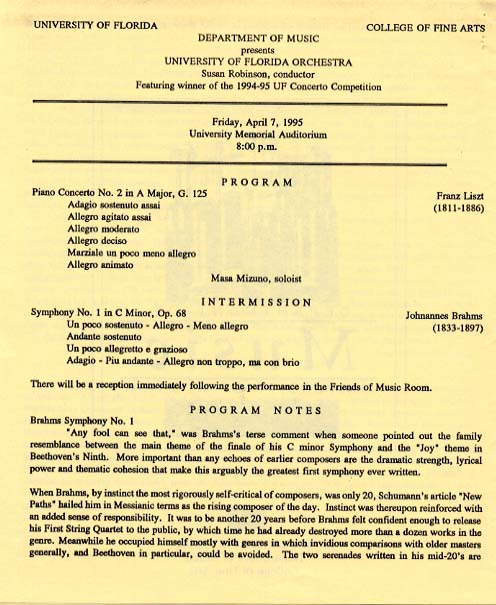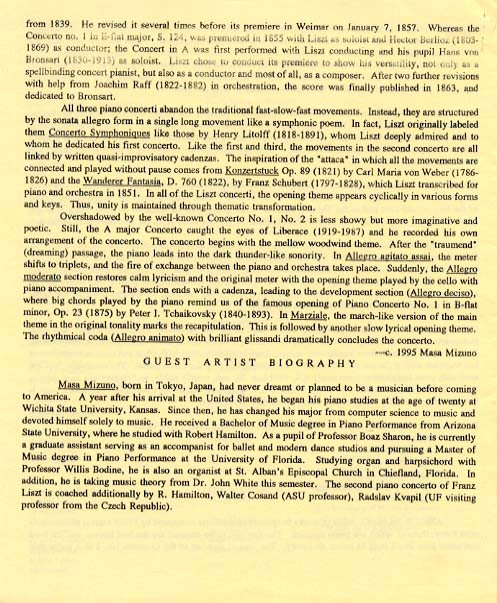

|
Piano Concerto No.2 in A major, S.125 (1839-1861) by Franz Liszt (1811-1886) Adagio sostenuto assai- Allegro agitato assai- Allegro moderato- Allegro deciso- Marziale, un poco meno allegro- Allegro animato |

|
Although the exact number of works for piano and orchestra composed by Franz Liszt is unclear, nine exist today, three of which are piano concerti. The first two piano concerti are the best known, and the third had never been heard until its recent discovery. The earliest sketches of Concerto No.2 in A major date from 1839. He revised it several times before its premiere in Weimar on January 7, 1857. Whereas Concerto No.1 in E-flat major, S.124, was premiered in 1855 with Liszt as soloist and Hector Berlioz (1803-1869) as conductor; the Concerto in A was first performed with Liszt conducting and his pupil Hans von Bronsart (1830-1913) as soloist. Liszt chose to conduct its premiere to show his versatility, not only as a spellbinding concert pianist, but also as a conductor and most of all, as a composer. After two further revisions with help from Joachim Raff (1822-1882) in orchestration, the score was finally published in 1863, and dedicated to Bronsart.
All three piano concerti abandon the traditional fast-slow-fast movements. Instead, they are structured by the sonata-allegro form in a single long movement like a symphonic poem. In fact, Liszt originally labeled them Concerto Symphoniques like those by Henry Litolff (1818-1891), whom Liszt deeply admired and to whom he dedicated his first concerto. Like the first and third, the movements in the second concerto are all linked by written quasi-improvisatory cadenzas. The inspiration of the "attacca" in which all the movements are connected and played without pause comes from Konzertstuck Op.89 (1821) by Carl Maria von Weber (1786-1826) and Wanderer Fantasia, D.760 (1822) by Franz Schubert (1797-1828), which Liszt transcribed for piano and orchestra in 1851. In all of the Liszt concerti, the opening theme appears cyclically in various forms and keys. Thus, unity is maintained through thematic transformation.
Overshadowed by the well-known Concerto No.1, No.2 is less showy but more imaginative and poetic. Still, the A major Concerto caught the eyes of Liberace (1919-1987) and he recorded his own arrangement of the concerto. The concerto begins with the mellow woodwind theme. After the "traumend" (dreaming) passage, the piano leads into the dark thunder-like sonority. In Allegro agitato assai, the meter shifts to triplets, and the fire of exchange between the piano and orchestra takes place. Suddenly, the Allegro moderato section restores calm lyricism and the original meter with opening theme played by the cello with piano accompaniment. The section ends with a cadenza, leading to the development section (Allegro deciso), where big chords played by the piano remind us of the famous opening of the Piano Concerto No.1 in B-flat minor, Op.23 (1875) by Peter I. Tchaikovsky (1840-1893). In Marziale, the march-like version of the main theme in the original tonality marks the recapitulation. This is followed by another slow lyrical opening theme. The rhythmical coda (Allegro animato) with brilliant glissandi dramatically concludes the concerto.
Copyright © 1995 Masa Mizuno


